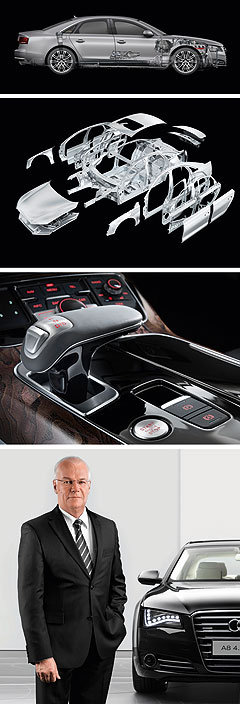Future models - Audi - A8Audi A8 ‘ride-on’ for comfortSmooth operator: A magic carpet ride was a major goal of the Audi A8 design and engineering team. Audi prioritises comfort over cornering as the A8 limo strives for ride benchmark1 Dec 2009 By BYRON MATHIOUDAKIS in MIAMI AUDI claims that it has bucked convention and answered ongoing criticism over ride quality by putting occupant comfort ahead of sporty handling for its third-generation A8. European drivers won’t know if that’s true until the first quarter of next year – at least six months ahead of the D4 series’ debut in Australia – but creating a cosseting and controlled environment dominated Audi’s communication for its Mercedes-Benz S-class, Lexus LS and BMW 7 Series competitor. This is despite the fact that the brand’s luxury flagship has adopted a variation of Audi’s MLB (Modulare Längsbaukasten) modular platform, which moves the major drivetrain components behind the front axle for improved dynamic capabilities. Revealed this week at the Audi-sponsored Design Miami design and art fair in Florida – which also served as the backdrop for the A8’s world premiere – chief vehicle development officer Michael Dick said every part had been changed so Audi could achieve its goal. Switching from the old A8’s four-link front suspension design to a five-link set-up (as in the current A4/A5 and upcoming A7 models that also share the MLB structure) was one of the biggest departures for the 15-year-old series.  From top: Audi A8 mechanical layout, A8 aluminium body exploded view, A8 controls, and Audi chief vehicle development officer Michael Dick. From top: Audi A8 mechanical layout, A8 aluminium body exploded view, A8 controls, and Audi chief vehicle development officer Michael Dick.Another was standardising air suspension on all models, giving the A8 what Mr Dick describes as a “much wider spread between comfort and dynamics, with a leaning towards comfort”. Audi’s head of suspension and drivetrain, Horst Glaser, added that he “cherry picked” the best possible individual air suspension components from a variety of competing suppliers to guarantee a more supple ride. Both of the engineers had the benefit of a clean-slate body structure to work from, since the A8’s trademark aluminium space-frame body (ASF) has become a significantly more advanced item than in the outgoing car. Heinrich Timm – the director of Audi’s Lightweight Design Centre at the old NSU factory in Neckarsulm, Germany – told GoAuto that his team worked on the A8’s aluminium structure for a number of years to improve stiffness by 25 per cent. Raising the different types of alloy used from about seven to 13 helped achieve this, as did the implementation of fully pressed aluminium doors, while a 20 per cent rise in the lightweight material’s quality employed within the ASF body boosted what was already a best-in-class structure in the six-year-old D3 A8 series. Mr Timm said that exploring the many different types of adhesives and methodologies necessary to bond all the exotic new and existing materials in the ASF also resulted in greater overall rigidity, along with improved durability and serviceability. He added that having a stronger structure was beneficial to the overall dynamic signature of a car – including ride quality – thus ticking another of Mr Dick’s to-do boxes for the latest A8. All these modifications, along with a host of other minor ones, highlight the growing importance of markets such as China and India, where most A8 buyers tend to be chauffeured and so demand best-possible ride quality from their limousines. Currently, Audi is the leading luxury car-maker in China. Comfort in the form of driver assistance technology was also prioritised in the new A8’s five-year gestation. This led to the overhaul of the Multi Media Interface system – one of the less lambasted types on the market in the past – as part of what Mr Dick calls a “revolution” on the inside of the A8. As one of the genuinely innovative features available as an option with the satellite navigation system, it includes a touch pad that recognises ‘hand writing’ in the form of letters scribbled individually by a person using his/her index finger. A world-first for a production vehicle, the touch-pad tech was devised and developed in-house, revealed interior designer Jens Sieber. “And I am very proud of it,” he said, adding that it was instigated to cut driver fatigue and frustration associated with previous navigation and telephone interfaces that often required a concerted amount of concentration on touch screens. Tellingly the touch-pad interface understands many languages besides English and German, and has been specially formulated with Chinese, Cantonese, Japanese, Cyrillic and Korean characters in mind. Finishing up on how comfort goals moulded the latest A8, Mr Dick included the D4 series’ class-leading silence at freeway speeds thanks to advanced aerodynamic (0.26Cd versus 0.31) the cabin’s low dashboard cowl for improved forward vision the inclusion of sophisticated audio and visual parking aids new-to-A8 lane-departure and vehicle blind-spot warning technologies a 20 per cent more efficient air-conditioning system vastly improved dash lighting and instrumentation markings and the ergonomically more ‘natural’ position of the aforementioned controller. Audi said that going 100 per cent LED for all lighting improves illumination and makes the night-time driving environment a better place for many owners. All these advancements, Mr Dick reiterated, were aimed to elevate the A8 as the world’s most comfortable car in its class while remaining the benchmark for safety, efficiency, economy, emissions and driver enjoyment.  Read more1st of December 2009  Audi A8 flagship evolvesAudi introduces what it calls its most ‘emotional’ luxury sedanA8 pricing
Motor industry news |
Click to shareAudi modelsResearch Audi A8 pricing
Motor industry news |
















Facebook Twitter Instagram